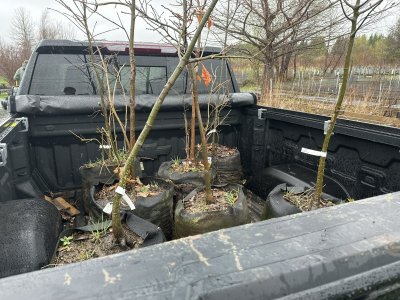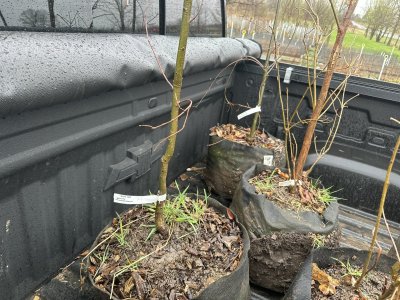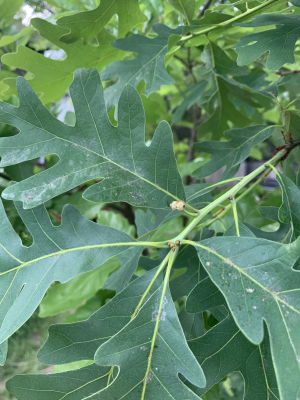-
If you are posting pictures, and they aren't posting in the correct orientation, please flush your browser cache and try again.
Edge
Safari/iOS
Chrome
You are using an out of date browser. It may not display this or other websites correctly.
You should upgrade or use an alternative browser.
You should upgrade or use an alternative browser.
Native and Non-Native Oaks
- Thread starter Belo
- Start date
That's a long time for a swamp white oak to put out 12 acorns. 5 year old trees can beat that in my area.I have northern reds and swamp whites that were planted at the same time as the sawtooth and English (about 2003). The swo had 12 acorns this past season (1st time they produced) and I haven't got a red yet. The sawtooth and English have been loaded for over 10 years.
The variance is interesting from region to region.
Teeder
5 year old buck +
That's why I have high hopes for the hybrids.That's a long time for a swamp white oak to put out 12 acorns. 5 year old trees can beat that in my area.
The variance is interesting from region to region.
rocksnstumps
5 year old buck +
I have talked myself out of planting hybrids for one reason. Bears. Need some decent growth before I want to see acorns or limbs are ripped off and tops busted. The faster growing burrs got pummeled. The slowest growing whites got limbs shredded but basic structure of a big tree intact.
If no bears in your neighborhood, hybrid away...
If no bears in your neighborhood, hybrid away...
Belo
5 year old buck +
We know oaks take a while, which is why I think people tend to go with food plots and chestnuts... just lack of patience. But I don't think an oak can be beaten for great habitat. I will probably spend a little more to buy some oaks that are a few years old already and maybe that helps get me a few years closer to production.That's a long time for a swamp white oak to put out 12 acorns. 5 year old trees can beat that in my area.
The variance is interesting from region to region.
Belo
5 year old buck +
help me understand why a hybrid is better than native? I see so many mixed opinions here. Is it truly ford vs chevy here? I'm in zone 6.I have talked myself out of planting hybrids for one reason. Bears. Need some decent growth before I want to see acorns or limbs are ripped off and tops busted. The faster growing burrs got pummeled. The slowest growing whites got limbs shredded but basic structure of a big tree intact.
If no bears in your neighborhood, hybrid away...
Teeder
5 year old buck +
Generally speaking, a hybrid should produce acorns at a younger age.help me understand why a hybrid is better than native? I see so many mixed opinions here. Is it truly ford vs chevy here? I'm in zone 6.
I like them for added diversity, and just because I think they're interesting.
Wind Gypsy
5 year old buck +
help me understand why a hybrid is better than native? I see so many mixed opinions here. Is it truly ford vs chevy here? I'm in zone 6.
I've been intrigued by hybrids for a number of reasons. The billing as faster growing and quicker to make acorns is pretty high on the list.
Being hybrid doesn't necessarily mean non-native. There are naturally occurring hybrids between native varieties.
One example of attributes that makes a hybrid appealing to me: i have some poorly drained ground and I'm at the northern edge of Swamp white oaks range. Bur oaks are the only white oaks i've got but they drop acorns very early. Enter swamp white x bur oak cross - should be well suited on my soils and drop later (than bur) with the swamp white component, more hearty (than SWO) from the bur component, and hopefully show the "hybrid vigor".
bwoods11
5 year old buck +
I’ve had Swamp white oak produce acorns on 5-6 years. Bur Oak & Swamp Bur hybrid have also produced fairly fast !That's a long time for a swamp white oak to put out 12 acorns. 5 year old trees can beat that in my area.
The variance is interesting from region to region.
Native Hunter
5 year old buck +
I can't be of much help for New York, but where I live Sawtooths are a welcome addition to my planting. They grow and produce quickly, and the deer love the acorns. My best producing native oak so far has been Swamp Chestnut Oak. The acorns are so sweet I can eat them myself without leaching. No, they don't taste as good as chestnuts, but compared to other oaks they are very low in tannins. These trees also started producing in just a few years.
PS - In my area trees in the red oak family will outgrow most trees in the white oak family and can eventually shade them out. So, take sunlight into consideration if you are planting something special. Last year I hinge cut a big red oak because it was starting to take over a spot with some dandy Swamp Chestnut Oaks that were producing well. It broke my heart to cut it, but it was the right thing to do.
PS - In my area trees in the red oak family will outgrow most trees in the white oak family and can eventually shade them out. So, take sunlight into consideration if you are planting something special. Last year I hinge cut a big red oak because it was starting to take over a spot with some dandy Swamp Chestnut Oaks that were producing well. It broke my heart to cut it, but it was the right thing to do.
Belo
5 year old buck +
So I made the 50 minute drive both ways to the nursery that was recommended. He was smaller than I had imagined, but I like supporting small bussinesses. It was a piss poor day raining and muddy. Helped him dig out the trees which were potted, but burried in mud and mulch.
In the commotion it wasn't clear to me which trees were which as we loaded up my truck and he gave me some tags and tagged a few so that I knew, but the tags I have don't add up and it's important that I plant the right trees in the right area.
I'm wondering how to identify which species is which? Does anyone have a trick or tip? I ended up with 3 swamp oaks that I plan to plant in a very wet poor draining area where many ash trees are dead or dying.
I also bought 2 white's and 2 red's. I'm unsure about the red's but I have them none the less.


In the commotion it wasn't clear to me which trees were which as we loaded up my truck and he gave me some tags and tagged a few so that I knew, but the tags I have don't add up and it's important that I plant the right trees in the right area.
I'm wondering how to identify which species is which? Does anyone have a trick or tip? I ended up with 3 swamp oaks that I plan to plant in a very wet poor draining area where many ash trees are dead or dying.
I also bought 2 white's and 2 red's. I'm unsure about the red's but I have them none the less.


omicron1792
5 year old buck +
Can identify them easily once they start to leaf out.So I made the 50 minute drive both ways to the nursery that was recommended. He was smaller than I had imagined, but I like supporting small bussinesses. It was a piss poor day raining and muddy. Helped him dig out the trees which were potted, but burried in mud and mulch.
In the commotion it wasn't clear to me which trees were which as we loaded up my truck and he gave me some tags and tagged a few so that I knew, but the tags I have don't add up and it's important that I plant the right trees in the right area.
I'm wondering how to identify which species is which? Does anyone have a trick or tip? I ended up with 3 swamp oaks that I plan to plant in a very wet poor draining area where many ash trees are dead or dying.
I also bought 2 white's and 2 red's. I'm unsure about the red's but I have them none the less.
View attachment 63748View attachment 63749
Teeder
5 year old buck +
Yep, I'd wait until they have leaves.Can identify them easily once they start to leaf out.
So I made the 50 minute drive both ways to the nursery that was recommended. He was smaller than I had imagined, but I like supporting small bussinesses. It was a piss poor day raining and muddy. Helped him dig out the trees which were potted, but burried in mud and mulch.
In the commotion it wasn't clear to me which trees were which as we loaded up my truck and he gave me some tags and tagged a few so that I knew, but the tags I have don't add up and it's important that I plant the right trees in the right area.
I'm wondering how to identify which species is which? Does anyone have a trick or tip? I ended up with 3 swamp oaks that I plan to plant in a very wet poor draining area where many ash trees are dead or dying.
I also bought 2 white's and 2 red's. I'm unsure about the red's but I have them none the less.
One benefit of them growing in those bags is you can wait till they leaf out to properly ID them and then plant where they need to go. The transplant shock should be avoided.
Wind Gypsy
5 year old buck +
What’d they charge for the bagged trees? Id like a few like that but they seem pretty rare, at least locally, in the hybrids I desire.
Angus 1895
5 year old buck +
It would be a cool experiment to plant seedlings of similar species next to the bagged trees and document growth over the years.
I would postulate the seedlings would surpass them in growth in under 10 years.
I would postulate the seedlings would surpass them in growth in under 10 years.
Last edited:
Similar threads
- Replies
- 17
- Views
- 667

